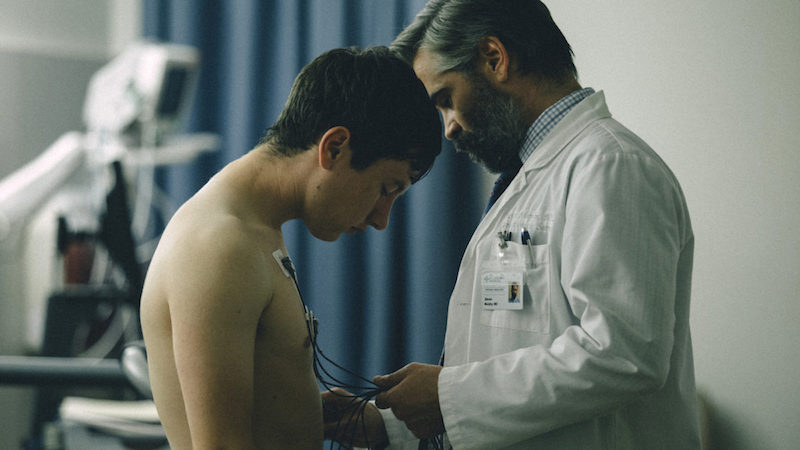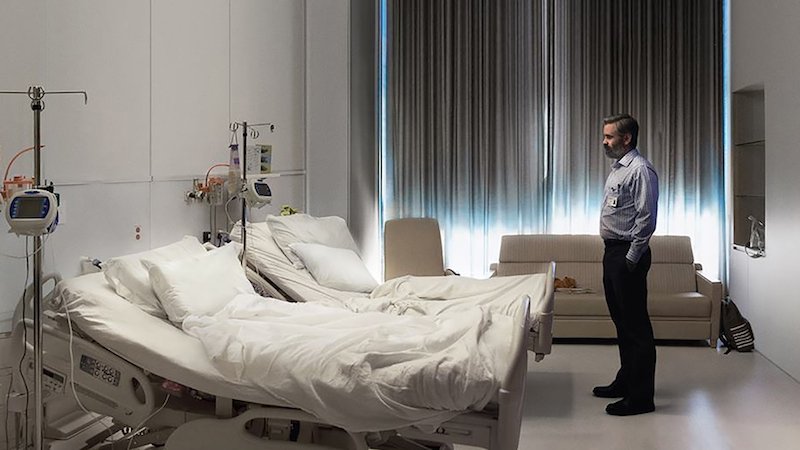At first glance, the meetings between heart surgeon Steven Murphy (Colin Farrell) and a 16-year-old boy, Martin (Barry Keoghan), lead one to fear the worst for the kid. Their stilted exchanges in public places, during which the man gives the teen expensive gifts, don’t suggest a family connection, or a mentor-student relationship, but a secret intimacy that can only be, in some way, dreadfully wrong.
But then Murphy takes the boy home to meet his ophthalmologist wife Anna (Nicole Kidman) and their two children. And before long the earlier assumption is turned on its head. In fact, Martin is going to turn into the family’s very worst nightmare.
Writer/director Yorgos Lanthimos has come a long way since his early films Dogtooth and Alps spearheaded the "weird wave" of Greek cinema. Those films were dark, absurdist critiques of the roles we play within family and society, brilliantly original and downright disturbing. His first English-language film The Lobster didn’t deviate from the approach – a surreal set-up, strangely stilted dialogue and a pessimistic world view – but this time he attracted Hollywood actors, garnered an Oscar nomination with his regular co-writer Efthimis Filippou, and started to steer his idiosyncrasies towards a wider audience. The new film consolidates that movement towards the mainstream. Colin Farrell (pictured above, with Keoghan) returns from The Lobster, now alongside Nicole Kidman, the pair reteamed following Sophia Coppola's The Beguiled. And for the first time Lanthimos applies his distinctive voice to what can more clearly be regarded as a genre piece – a psychological thriller that comes very close to horror. But if on paper this is his most accessible film to date, it’s inescapably Lanthimos’s world and perspective. And once again the family unit crumbles under his gaze.
The new film consolidates that movement towards the mainstream. Colin Farrell (pictured above, with Keoghan) returns from The Lobster, now alongside Nicole Kidman, the pair reteamed following Sophia Coppola's The Beguiled. And for the first time Lanthimos applies his distinctive voice to what can more clearly be regarded as a genre piece – a psychological thriller that comes very close to horror. But if on paper this is his most accessible film to date, it’s inescapably Lanthimos’s world and perspective. And once again the family unit crumbles under his gaze.
It opens with a jolt – a loud blast of gloomy Schubert accompanying an icky, close-up view of open-heart surgery. This is the sharp end of the surgeon’s professional world, you might say, and it’s one in which Murphy is not quite as dependable as his reputation and smug demeanour would suggest.
This chap could be a leaner, more confident relation to Farrell’s character in The Lobster, the two bonded by bad facial hair (last time an appalling moustache, now an intensely bushy, salt-and-pepper beard), dubious moral standing, and the dead monotone that the actor has perfected for his director. But you might say their journeys are reversed: before, Farrell’s outlawed singleton grew in authority and control; the surgeon plummets in the other direction.
There’s no denying the brilliance of the execution throughout the film
At home, Murphy seems surprisingly well-adjusted as husband and father, notwithstanding his and Anna’s penchant for kinky sex with an operating room theme. So what’s the deal with the boy? The film’s title refers to the Greek myth of Iphigenia, who was offered as a sacrifice by her father Agamemnon to placate the offended goddess Artemis. Without giving too much away, Martin is the Artemis in this scenario, demanding twisted payback and with seemingly preternatural power over the family, which will leave Murphy with a terrible choice to make.
Whereas the impact of Lanthimos’s previous films has derived from the situation and script, here the cinematography – from another regular collaborator, Thimios Bakatakis – plays a much more prominent role. With long tracking shots (often following Murphy from above), dramatic pans, low-angles and fish-eye, the camera (aided by Johnnie Burn’s harsh atonal sound design) creates a constant sense of strangeness and foreboding. It’s very reminiscent of Stanley Kubrick; one grand, beautifully lit interior particularly evokes Eyes Wide Shut, which incidentally also featured a smug doctor way over his head, who happened to be partnered by Nicole Kidman.
There’s something of Kubrick’s oddball humour here, too, as when Martin takes Murphy home to meet his mother (a surprising appearance by Alicia Silverstone), who suddenly gets the hots for her guest, and whose insistence that “I won’t let you leave till you’ve tried my tart” is a delicious combination of clumsy seduction and threat. But as the boy turns the screw in the final reel, Kubrick gives way to Michael Haneke, and the sort of appalling dilemma that the Austrian used to revel in, particularly around the time when Funny Games set a new, perverse standard for an audience’s emotional participation.
But as the boy turns the screw in the final reel, Kubrick gives way to Michael Haneke, and the sort of appalling dilemma that the Austrian used to revel in, particularly around the time when Funny Games set a new, perverse standard for an audience’s emotional participation.
The echo of Haneke and a brand of almost unwatchable horror takes the edge off the film for me; it’s certainly effective, but feels hackneyed and a bit cheap. That said, there’s no denying the brilliance of the execution throughout the film, the compelling mystery of what the boy can, and will do to satisfy himself, and another provocative account of the finer points of the family dynamic, here including the need, sometimes, just to survive.
The acting is spectacular. Farrell again offers the perfect manifestation of Lanthimos’s view of stunted humanity. And like Kubrick, the director can’t get enough of Kidman in close-up, in which she offers a steely woman embracing her terrifying predicament and calculating the odds of surviving it. Raffey Cassidy and Sunny Suljic are perfect as the temperamental, suffering siblings, and Keoghan – recently so sweet as the doomed, wannabe civilian hero in Dunkirk – manages to make Martin at once awkward and cunning, vulnerable and sinister. It's a remarkably chilling performance.














Add comment